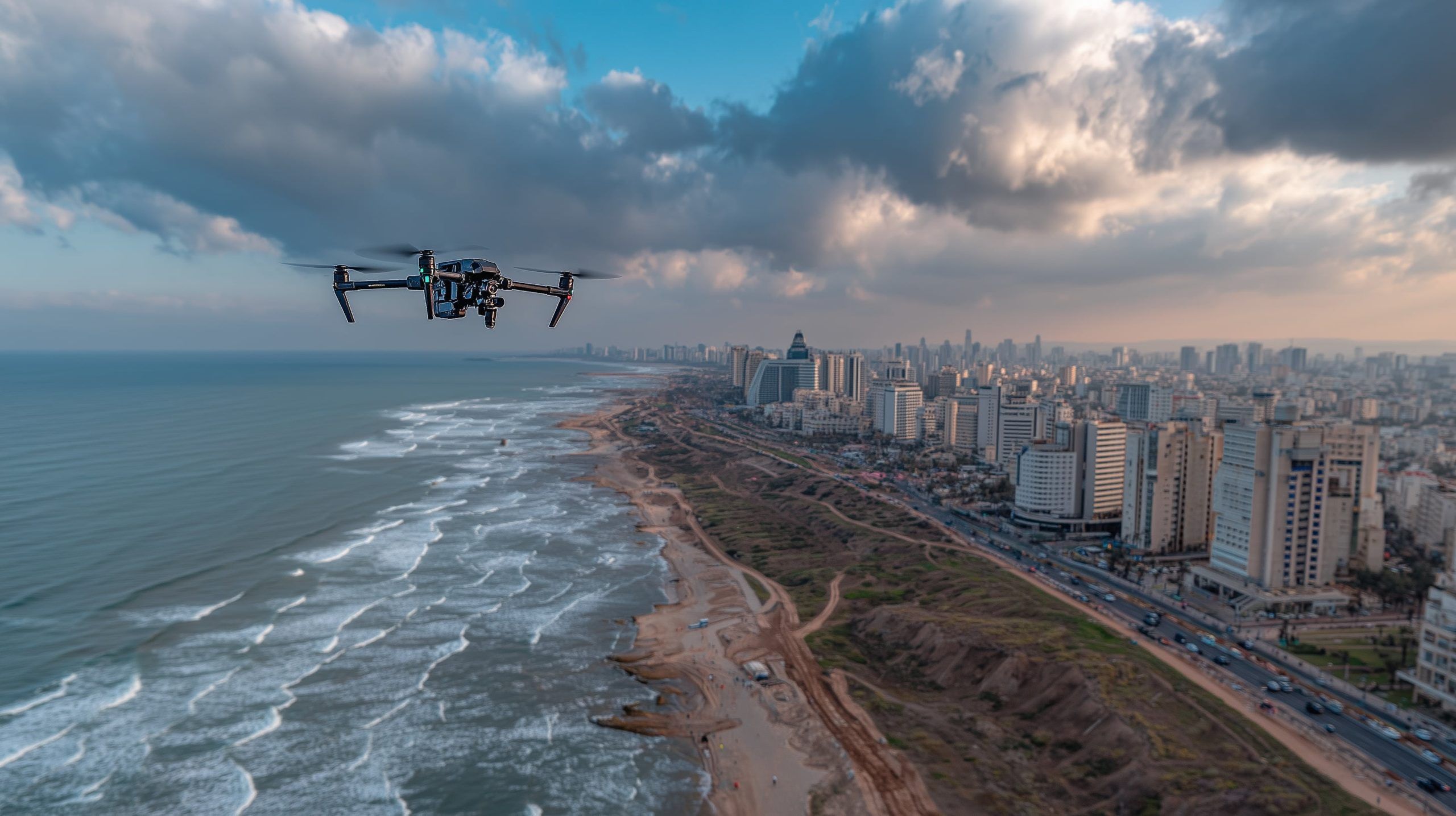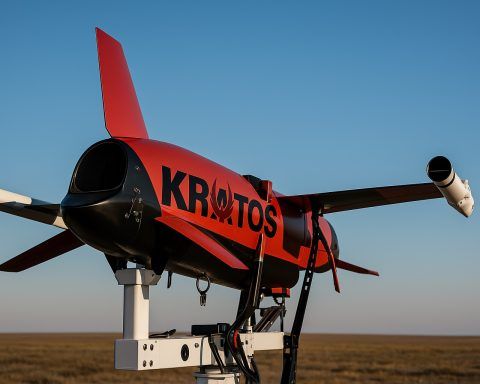- Recreational Drone Operator License is required for hobbyists in Israel, often called a “matayesen” or UAS operator certificate, with applicants as young as 12 and an online theory exam, and minors under 16 must fly under adult supervision.
- Drones over 250 grams must be registered with the Civil Aviation Authority of Israel (CAAI) in the online registry, carry an owner ID label, and pass a written knowledge test, with a registration fee around ₪30.
- Drones under 250 grams may be exempt from formal registration under upcoming rules, but any drone with a camera remains subject to Israel’s drone laws.
- The maximum altitude for recreational flights is 50 meters above ground, with draft rules suggesting 60 meters and waivers up to 100 meters on a case-by-case basis.
- Drone operators must maintain Visual Line of Sight (VLOS) at all times and cannot fly BVLOS.
- Drones must stay at least 250 meters from uninvolved people or buildings and at least 2 kilometers from any airport or airfield, and may not fly directly over people.
- Israel maintains extensive No-Fly Zones including airports, military bases, border areas, nature reserves, and urban centers, with official maps from ICD and CAAI updated weekly.
- Commercial drone operations require an advanced UAS Operator License from CAAI, typically costing around ₪300, and foreign licenses are not recognized; foreigners must partner with an Israeli-licensed operator.
- Since November 2023, all drones over 200 grams must connect to Israel’s national UTM system and broadcast ID and telemetry (Remote ID), with options including built-in Remote ID, a broadcast module, or High Lander’s Vega UTM service.
- Enforcement is multi-agency (CAAI inspectors, Israel Police, IDF counter-drone measures) with penalties including fines up to ₪70,000, possible drone confiscation, and detention.
Thinking of flying a drone in Israel? Drone use is legal in Israel, but it’s subject to some of the strictest regulations in the world [1]. The rules cover everything from licensing and registration to no-fly zones, altitude limits, and privacy concerns – all shaped by Israel’s unique security needs. This comprehensive guide breaks down all aspects of Israel’s drone laws for recreational flyers, commercial operators, and even foreign visitors. Read on to learn about required permits, restricted zones, recent regulatory changes, and official resources before you take off in the Israeli skies.
Recreational Drone Use Regulations in Israel
Recreational drone pilots in Israel must follow strict rules and even obtain a license. Key regulations for hobbyists include:
- Mandatory “Recreational Drone License” – All recreational users need a drone operator license (often called a “matayesen” license). Applicants must be at least 12 years old and able to read and speak Hebrew or English [2]. Obtaining the license requires passing an online theory exam on drone safety and regulations [3]. This process ensures hobbyists understand the rules (e.g. knowing no-fly zones, max flight altitudes, etc.). Minors under 16 can fly under adult supervision once licensed [4] [5].
- Drone Registration – Recreational drones above a certain weight must be registered with the Civil Aviation Authority of Israel (CAAI). Under draft regulations, any drone over 250 grams (up to 25 kg) must be registered in a CAAI system [6]. The owner/operator’s details are recorded, and the drone must carry an identification label with the registration and owner info [7] [8]. Registration can be done online (available in English) and involves a small fee (around ₪30 NIS for locals) [9]. As part of registration, owners must pass a written knowledge test (online) covering the rules like no-fly zones, max height, permitted hours, etc. [10]. Note: Drones under 250g may be exempt from registration under upcoming rules [11], but if they have a camera, they’re still subject to Israel’s drone laws due to security concerns [12]. In practice, any drone with a camera – even a toy – must follow the same laws in Israel [13].
- Operational Limits for Hobbyists – Recreational pilots must obey strict flight restrictions:
- Maximum Altitude:50 meters (164 feet) above ground is the limit without special permission [14] [15]. (A draft rule may raise this to 60m, with case-by-case permits up to 100m, but 50m remains the general limit) [16].
- Visual Line of Sight (VLOS): You must keep your drone within direct eyesight at all times (no BVLOS flights) [17] [18].
- Distance from People/Buildings: It’s illegal to fly over or close to uninvolved people. Drones must stay at least 250 meters (820 ft) away from residential areas, gatherings of people, and structures [19] [20]. Flying directly above people is expressly forbidden [21].
- Airports and Aircraft:No flying within 2 km (1.2 miles) of any airport or airfield [22] [23]. Also steer clear of active aircraft – drones must not interfere with planes, helicopters, gliders, hot air balloons, etc. [24].
- Time of Day: Only daylight VFR conditions are allowed for basic recreational flights (night flying would require special authorization).
- No dropping of objects or carrying weapons: Drones cannot be used to drop items or carry anything dangerous (weaponizing civilian drones is strictly prohibited by law).
- No careless or reckless flying: Operators must not fly “carelessly in a way that will cause danger to human life” [25]. Safety checks of the drone’s systems before flight are required by regulation [26].
- No-Fly Zones: Israel has extensive no-fly zones that recreational pilots must avoid (detailed in a later section). These include obvious areas like airports and military zones, but also residential city centers, national parks, border regions, and critical infrastructure [27] [28]. Pilots are expected to know and respect these prohibited areas – ignorance is not an excuse, and an online map of no-fly areas is provided by authorities (see “No-Fly Zones” section below).
Overall, flying for fun in Israel is possible but tightly controlled. You must get licensed, register your drone, and fly only in allowed areas under strict limits [29] [30]. Always carry proof of your drone license and registration when flying, as officials may ask to see them.
Commercial Drone Use Regulations in Israel
Using drones for any commercial or business purpose in Israel requires additional steps beyond the recreational rules. Key points for commercial drone operators:
- Licensing for Commercial Operators: Unlike recreational users (who need a basic license), commercial drone pilots must obtain an advanced operator license from CAAI [31]. All commercial drone operations require a license – there is no exception [32] [33]. Pilots have to undergo more extensive training and pass a thorough exam. The commercial licensing exam covers advanced knowledge (airspace rules, safety, aviation law, etc.) and costs around ₪300 NIS in fees [34]. Only licensed individuals or companies may legally offer drone services (aerial photography, surveying, deliveries, etc.) in Israel.
- Operational Requirements: Commercial drone flights are generally limited to the same baseline rules as recreational (VLOS, 50m altitude, daylight only, etc.), but with some additional constraints and permission requirements:
- To fly near structures or populated areas for commercial tasks (e.g. building inspections, urban filming), operators must obtain a special permit. For example, flying within 500 feet of any structure requires a specific authorization from CAAI [35]. This ensures extra safety precautions in urban environments.
- Certain operations beyond the standard limits (e.g. night flights, above 50m/60m altitude, flying over people, or beyond visual line of sight) are possible for commercial use but only through explicit CAAI waivers. Israel’s framework will allow Part 107-style waivers for these advanced operations on a case-by-case basis [36] [37]. Each waiver or permit request is evaluated individually, and CAAI plans to publish granted waivers for transparency (similar to the U.S. FAA approach) [38].
- Equipment standards: Drones used commercially may have to meet certain equipment requirements, such as having remote identification capability (more on this in “Recent Changes” below) and possibly drone parachutes or other safety features, depending on the operation. All drones over 250g used commercially must be registered, labeled, and meet any drone ID marking requirements set by CAAI [39] [40].
- Insurance: While liability insurance for drone operations isn’t currently mandated by law for civilians, it is highly recommended for commercial operators. Given the dense urban areas and high risk, many companies carry drone insurance to cover third-party damage or injuries. (Some countries require insurance; Israel’s regulations have not made it compulsory yet [41] [42], but it remains a best practice to have coverage.)
- Foreign Commercial Operators:Tourists or foreign entities cannot directly conduct commercial drone activities in Israel under their own license. In fact, Israel does not recognize foreign drone licenses or allow foreigners to obtain an Israeli commercial license [43]. If you’re a foreign filmmaker, researcher, or business wanting to use drones, the rule is to partner with a locally licensed operator. The Israeli Drone Organization (ICD, operated under CAAI) explicitly states that visiting foreigners are only allowed to fly recreationally. Using a drone for any “business purposes” (e.g. paid filming, research, mapping) as a tourist is prohibited unless you hire an Israeli-licensed drone pilot to perform the work for you [44] [45]. This ensures all commercial work is under the oversight of licensed residents.
In summary, commercial drone use in Israel is heavily regulated but feasible if you go through the proper channels. Local businesses have a pathway to get licensed and operate, albeit under strict operational limits and oversight. Foreign companies must collaborate with Israeli operators. As Israel moves toward a modern regulatory framework, expect clearer standards (similar to FAA Part 107) to govern commercial drones, with a balance between enabling business and ensuring safety/security [46] [47].
Drone Registration Rules and Procedures
Drone registration is a cornerstone of Israel’s drone laws for both residents and visitors. The aim is to account for every drone and link it to an owner, given security concerns. Here’s what to know about registration:
- Which Drones Must Be Registered:All drones weighing over 250 grams (0.55 lbs) are subject to mandatory registration with the CAAI, under proposed rules [48]. This aligns with global trends (many countries use 250g as a cutoff), but Israel is even moving toward a 200g threshold for certain requirements (as discussed under UTM/Remote ID) – more on that later [49] [50]. Drones under 250g might be exempt from the formal registration process once new regulations are final, effectively treating sub-250g craft as toys [51]. However, any drone with a camera, regardless of weight, is treated seriously – so even if registration paperwork isn’t required for a 249g drone, you must still follow all flight rules and you may be asked to inform authorities of your activities [52]. Practically speaking, if you have a camera drone, it’s wise to register it to avoid issues.
- Registration Process for Residents: Local drone owners (Israeli residents) typically register through the CAAI’s online portal (available via the gov.il website). To register, you need to provide personal details and information about your drone (make, model, serial number) [53]. You also need a form of ID and payment method for the fee [54]. The process includes creating an account and completing an online knowledge test about drone rules [55]. Once passed and paid, your drone is added to the national registry, and you should mark your drone with the assigned registration number and your contact info [56]. The minimum age for registering as an owner is 16 (younger operators use their guardian’s registration) [57]. The registration is typically a one-time process per drone, though regulations may require updating the CAAI if you sell the drone or if it’s lost/destroyed [58].
- Registration for Foreign Visitors: Tourists cannot use the regular CAAI portal directly; instead, the Israeli Drone Organization (ICD) facilitates a combined permit/registration for visitors. Before bringing a drone to Israel, foreign pilots should apply for a “Drone Operator’s Permit for Visitors” through the ICD’s website [59] [60]. This online registration serves multiple purposes: it covers CAAI flight authorization, Ministry of Communications approval for the drone’s radio frequencies, and even a customs clearance exemption [61] [62]. You’ll need to submit your personal info, travel dates, drone details (model & serial), and a declaration that you’ll only fly recreationally [63] [64]. A fee of about $100 USD is charged for the tourist drone permit [65]. Processing takes a few days, and you receive an official permit via email, which you should carry (printed or digital) when entering Israel and when flying [66]. This permit effectively registers your drone for the duration of your stay. It must be renewed every 3 months if you stay longer or make repeat visits [67].
- Import Permit & Customs: An important aspect of bringing a drone is the import approval from the Ministry of Communications (MoC). Because drones have transmitters (for control and camera), they are considered communication devices. Israel requires an import permit for such devices. The ICD tourist registration process includes getting you an MoC permit so that customs will let your drone into the country duty-free [68] [69]. If you do not obtain this approval in advance, customs can hold your drone until you secure the permit, and trying to import without a permit is an offense that can incur fines [70]. According to Israeli authorities, failing to get import approval before the drone arrives is illegal and may lead to a monetary penalty [71]. So, whether you apply before travel or after landing, ensure you follow the import rules. (The ICD streamlines this by handling it on your behalf during registration.)
- Registration Proof: Upon successful registration (for locals or tourists), you should receive a document or certificate of registration/permit. Keep this with you as you fly. Law enforcement or air traffic authorities may ask to see proof that your drone is registered and you are authorized to fly. Additionally, make sure your drone is marked with your registration ID and contact info as required [72] – this helps authorities identify a drone’s owner if it’s found or in case of an incident.
In essence, Israel wants a record of every drone and its operator. Registration is a legal requirement and also a way to educate pilots (via the test). Compliance is crucial – it not only keeps you legal, but also indicates to authorities that you’re a responsible pilot. Always register before flying, and if you’re a visitor, don’t skip the ICD permit process before bringing your drone.
Drone Operator Licensing and Certifications
Beyond simply registering the drone, pilots themselves may need certification or licensing, depending on their activities:
- Recreational Flyer Certificate: As noted, Israel requires even hobby pilots to get a Recreational Drone Operator License. This is unusual compared to many countries, but Israel treats drone piloting similar to driving a vehicle – you need a basic license. The process involves online self-study (CAAI provides study materials in Hebrew, and an English version may be available) and passing an online multiple-choice exam [73]. The exam tests knowledge of aviation rules, drone operation principles, safety, and local regulations. Once you pass, you receive your license (often digital). This license may be referred to as a “UAS operator certificate (recreational)”. It’s important to note that you must carry your license while flying, and it might have an expiration (e.g. valid for a couple of years, after which you may need a refresher or renewal – check the CAAI’s terms). For youth under 16, the license likely requires a parent/guardian’s consent and supervision during flights [74].
- Commercial Pilot License: For anyone intending to fly drones for profit or business in Israel, obtaining a Commercial UAS Operator License (essentially Israel’s equivalent of a Part 107 certification) is mandatory [75] [76]. CAAI has a licensing program where candidates might need to undergo formal training or ground school, log practical flight hours, and pass a more rigorous exam (potentially in-person). The license ensures the pilot understands advanced airspace classifications, meteorology, emergency procedures, and can safely integrate into the national airspace at a professional level. The cost for the exam/license process is about ₪300, and there could be additional fees for practical test or coursework [77]. Commercial licenses are typically issued to adults (18+). Businesses operating multiple drones will also need to ensure each pilot on staff has the license, and the company itself might require an operating certificate from CAAI (depending on scale of operations).
- No Foreign License Reciprocity: Israel currently does not accept foreign drone pilot licenses or certifications. For example, having an FAA Part 107 (USA) or an EASA certificate (EU) does not allow you to bypass Israeli requirements. CAAI’s draft regulations explicitly state there is no registration of foreign operators in the Israeli system [78]. So even experienced foreign pilots must either fly under the recreational rules as tourists or work with local licensed pilots for commercial needs. There is no shortcut to “convert” a foreign license into an Israeli one at this time.
- Additional Certifications (Special Operations): If you plan specialty drone operations (e.g. agricultural spraying, drone deliveries, etc.), be aware that additional certifications or training might be needed. The proposed framework in Israel mentions specific requirements for agriculture (spraying drones might need special approval and pilot training beyond basic commercial license) [79]. Likewise, if drone delivery trials are ongoing, pilots might need to be part of a certified program. Always check with CAAI if your use-case is out of the ordinary; they may issue operational certificates or guidelines for new drone applications as the tech evolves.
- Permit from Ministry of Communications: One often overlooked “certification” is the permit from the Ministry of Communications (MoC) regarding the drone’s radio frequencies. For residents, type-approved drones (like DJI models) are generally known to CAAI/MoC. But if you are importing a custom or high-end drone, you might need a radio operator permit or frequency allocation from MoC. Particularly, operating on the 5.8 GHz band (commonly used for drone video feeds) used to be forbidden for civilian drones in Israel [80]. Until recently, only 2.4 GHz was allowed for hobby drones, as 5.8 GHz was reserved for military use [81]. Now, authorities are gradually allowing 5.8 GHz use with a special permit from MoC [82]. New DJI drones typically auto-adjust to legal frequencies based on GPS location [83], but if your drone transmits only on 5.8 GHz, you must obtain permission or risk confiscation and fines [84] [85]. The tourist permit via ICD includes checking this box, but Israeli residents who build or modify drones might need to contact MoC for a “wireless device” permit. Always ensure your drone’s control and video link frequencies are legal and approved in Israel.
In short, drone pilots in Israel need to be qualified and authorized. Get the proper license for your category (recreational vs. commercial), and ensure any technical permits (like frequency use) are in order. These certifications not only keep you compliant but also signify that you are a responsible operator, which is crucial given Israel’s focus on safety and security.
Designated No-Fly Zones in Israel
Israel has extensive no-fly zones (NFZs) where drone operations are prohibited or heavily restricted. These zones are in place primarily for security, safety, and privacy reasons. It’s critical for drone pilots to know and avoid these areas – violating them can lead to serious consequences. Major categories of no-fly zones include:
- Airports and Airfields: All international and domestic airports, as well as smaller airstrips, have a protective radius. Drones must stay at least 2 kilometers away from any airport or airfield [86] [87]. This is a blanket rule to prevent interference with manned aircraft during takeoff and landing. Additionally, you should avoid flight paths of aircraft; even outside 2 km, if you are near a known flight corridor, exercise caution or avoid it. Major airports like Ben Gurion (near Tel Aviv) will have an even larger controlled airspace – parts of it likely cover more than 2 km, so always err on the side of a larger buffer.
- Urban Centers and Residential Areas: Unlike some countries that allow drone flights over cities under certain conditions, Israel largely forbids flying over or within residential neighborhoods and cities without special permission. You must stay at least 250 m away from residential buildings, urban areas, and any gathering of people [88]. This effectively makes cities like Jerusalem, Tel Aviv, etc., no-fly zones for hobby drones at low altitudes. Flying over Jerusalem’s Old City or holy sites is explicitly advised against [89] – not only due to crowds but also sensitive security around these areas. In practice, any area with dense population or public activity is off-limits unless you have a rare permit (which would only be given to professional operations with safety measures, if at all).
- Military and Security Zones: Israel’s military bases, training areas (“fire areas”), and border security zones are strictly no-fly [90]. Do NOT fly near or into IDF bases or installations, even if they’re not explicitly marked on public maps. Border areas (like the frontiers with Lebanon, Syria, Gaza, Egypt, Jordan) are extremely sensitive – a drone near a border could be misidentified as a threat. The IDF has counter-drone systems and will intercept drones near borders; if you’re the operator, expect to be detained and questioned [91]. Even tourists have been interrogated for flying innocently near borders because authorities treat it very seriously [92]. Additionally, police stations, prisons, and critical infrastructure (power stations, refineries, water facilities) are considered security zones – drones must keep clear of them by a wide margin [93] [94].
- Nature Reserves and National Parks: Israel places importance on protecting wildlife, especially due to its role in migratory bird routes. Nature reserves and national parks are generally no-fly zones for drones [95]. The Nature and Parks Authority has its own restrictions – for example, drone use is banned in certain parks to prevent disturbing endangered birds and wildlife [96]. There are specific periods (months) when restrictions may be eased in some areas, but one should assume parks are off-limits unless explicitly allowed. If in doubt, check with park authorities or the ICD. On the official maps, some nature protection zones are marked (often in green or purple on the NFZ map) [97].
- Special Events and Crowds: It is forbidden to fly over or near crowds of people, concerts, demonstrations, festivals, or sports events (like stadiums) [98]. These temporary no-fly restrictions aren’t always on published maps, but are common sense and often legally enforced via NOTAMs or police measures. For example, a big soccer match or a public gathering might have a drone ban – flying there could get your drone confiscated by police or worse.
- Temporary Restricted Areas: At times, Israeli authorities declare temporary no-fly zones (often via NOTAM – Notice to Airmen) for certain regions, especially during high security events or military operations. It’s important to stay updated – for instance, during state visits, parts of a city might be off-limits. If you’re a commercial operator, you should monitor NOTAMs. Recreational users should keep an eye on local news or the ICD updates; when in doubt, ask ICD or CAAI.
How to Know the No-Fly Zones: The Israeli Civil Aviation Authority provides maps of low-altitude no-fly zones. The Israeli Drone Org (ICD) maintains an interactive online map highlighting restricted areas [99]. This map is updated weekly and color-coded by category of restriction (e.g. nature reserves, security zones, airports marked in different colors) [100] [101]. Pilots should consult these maps before every flight to ensure their planned location is not in a forbidden area. Additionally, DJI’s geofencing maps also reflect many Israeli NFZs (DJI drones won’t take off in red zones unless unlocked with proof of permission) [102]. However, do not rely solely on your drone’s software – always double-check the official map, as some areas might not be hard-coded into drone firmware.
In summary, Israel’s no-fly zones cover a large portion of the country’s sensitive areas – from airports and military zones to city centers and parks. Safe flying is mostly relegated to open areas well away from people, borders, and infrastructure. Always plan your flight location carefully. When in doubt, assume an area is restricted and seek guidance (ICD even offers a contact for queries [103]). Respecting no-fly zones is crucial – the authorities have little tolerance for errant drones in sensitive airspace.
Altitude and Distance Restrictions
In addition to geographic no-fly zones, Israel’s drone laws impose strict altitude and horizontal distance limits to ensure safety:
- Maximum Flight Altitude – 50 Meters: Drones in Israel may not fly above 50 meters (164 feet) from the ground [104] [105]. This low altitude ceiling is significantly stricter than many countries (for comparison, the US and EU generally allow up to ~120m). The rationale is to keep drones very low, well separated from manned aircraft and to limit their range. Exceeding 50m without special permission is a violation and can draw enforcement if noticed. As mentioned, new rules might officially set it at 60m with an option up to 100m on special approval [106], but until that is enacted, stick to 50m AGL as your hard limit. Always monitor your drone’s altitude via telemetry to ensure compliance.
- Vertical Distance from People/Objects – Don’t Overfly People: You must maintain a safe vertical distance as well – essentially, do not fly directly overhead any person who’s not part of your operation [107]. Flying above people is banned because of the risk if the drone fails. Similarly, you shouldn’t hover directly above buildings or vehicles on the ground either. Even at 50m height, overflight of uninvolved people is not allowed.
- Distance from Airports – 2 Kilometers Minimum: We covered this under no-fly zones but to reiterate: always keep at least 2 km away horizontally from any airport’s perimeter [108]. This also applies to helipads and smaller airstrips (they might have slightly smaller recommended distances, but 2 km is a safe rule). Note that if you’re flying near an airport outside the 2 km zone, the 50m height still applies, and if you see any low-flying aircraft (like a helicopter), you should descend/land immediately.
- Distance from People, Buildings, Roads – 250 Meters: Israeli regulations forbid flying a drone within 250 meters (820 feet) of people or structures [109] [110]. This means if you’re flying in an open area, you should be more than 250m away from the nearest uninvolved person or building. In practical terms, 250m is roughly 2.5 football fields – quite far. This rule essentially prevents drone use in built-up areas or near crowds. Always pick a location where you have a 250m buffer to any bystanders or houses. Note: The draft regulation in 2019 also mentioned not flying closer than 250m to infrastructure like roads, neighborhoods, or any place containing people [111].
- Keep Your Distance from Sensitive Sites: Though already covered under no-fly zones, the law’s distance-based approach means even if you’re outside a prohibited area, you must not encroach within a certain range. For example, stay well outside the fences of a military base or prison – give far more than 250m in those cases, as any incursion could trigger security responses. The same goes for borders – maintain a significant distance. The ICD guide literally lists: “It is forbidden to fly near/into military bases… near/into border areas… near/into security facilities” [112]. In practice, “near” in those contexts would likely be interpreted as anything within a few kilometers could raise alarm. So exercise extreme caution geographically.
- Line of Sight and Visual Range: While not a fixed distance number, VLOS (Visual Line of Sight) is required [113], which inherently limits how far you can fly your drone. Practically, most small drones become hard to see beyond a few hundred meters away. You should never rely solely on FPV camera; always maintain eyes on the drone. The law mandates continuous eye contact with the aircraft [114]. Using a visual observer can help if you need to fly a bit farther out, but the observer must also keep direct sight. There’s no exact meter limit specified for range, but if your drone goes so far that you can’t tell its orientation or see what’s around it, you’ve likely exceeded VLOS and the spirit of the law. As a rule of thumb, staying within 300-500m of the pilot is advisable unless you have special approval.
- Flight Speed: Although not always highlighted in summaries, expect that drones should be flown at a safe speed. Fast racing drones or large UAVs might introduce separate speed or kinetic energy restrictions, especially near people. Israel’s rules (similar to Part 107) likely include that drones must be operated at a speed where the pilot can react and avoid collisions within VLOS. If you’re flying a FPV racing drone recreationally, do it in a deserted area and within line of sight limits, otherwise it could be deemed careless/reckless if at high speeds near any person or property.
- Altitudes for Special Operations: If you have special permission for an operation, the altitude might be raised on a case-by-case basis (e.g., up to 100m for certain surveys with CAAI approval) [115]. Also, for indoor drone flights, note that the regulations consider those differently – a drone operating entirely indoors is not considered a “drone” under the aviation rules [116]. But the moment it goes outdoors, all these limits apply.
In summary, the legal envelope for drone flight in Israel is a low-altitude, relatively short-distance bubble around the pilot. Stay under 50 m high, no farther than you can see, and keep a football-field distance from any people or structures. These strict limits are meant to minimize risk and nuisance. Always plan your flight accordingly – pick wide-open, unpopulated spaces and keep your drone close and low.
Privacy and Data Protection Laws for Drone Use
Flying a drone in Israel isn’t just about aviation rules – privacy laws are also a concern, especially when using cameras. Israel does not yet have a drone-specific privacy statute, but general privacy and data protection laws apply to drone operations:
- General Privacy Law: Israel’s main privacy legislation is the Protection of Privacy Law, 1981, which protects individuals’ privacy rights. Under this law, capturing or publishing identifiable images of a person without consent could be considered a violation of privacy in many cases. For drone pilots, this means you should avoid filming people in private places or conducting surveillance. Peering into someone’s backyard or window with a drone camera would likely breach privacy laws, similar to ground photography rules. Always respect people’s privacy – if you wouldn’t stick a telephoto lens over someone’s fence, don’t do it with a drone.
- Data Protection Regulations: Israel’s Privacy Protection Authority (PPA) has recognized drones as potential tools of data collection. In 2018, the PPA issued draft guidelines for drone use focusing on privacy [117] [118]. These guidelines (though not law per se) set important principles:
- Necessity & Purpose: Only use drones for a legitimate purpose after considering if less-intrusive alternatives exist [119]. Essentially, don’t use a drone to collect data if you don’t really need to.
- Proportionality:Minimize the personal data you collect – e.g., if using a drone for a specific task, avoid recording unrelated people or property [120]. Don’t use higher resolution or longer recording time than necessary.
- Transparency: Inform the public when drones are being used for data collection [121]. For example, authorities or companies should post notices if an area is under drone surveillance, or announce drone usage on websites or signs. Even as a private user, it’s wise to let people around you know you’re filming scenery, not them, to alleviate privacy concerns.
- Security of Data: If you record data (videos, photos), you are responsible for securing that data. The PPA guidelines say any collected personal info via drones must adhere to Israel’s data security regulations [122]. Practically, if you’re a photographer, keep footage safe and don’t inadvertently leak sensitive images.
- No Fly over Private Property: While not explicitly an aviation rule, flying over someone’s private property could lead to privacy and trespass complaints. Israeli homeowners are quite sensitive due to security; a drone hovering over a backyard might be reported to police. There’s an implied expectation of privacy in private domains. So avoid flying low over homes, and definitely avoid recording in a way that identifies persons or interiors.
- Enforcement of Privacy Violations: The PPA in Israel can investigate misuse of drones for data collection. As of 2020, they were drafting regulations to limit how much personal info governments and companies can gather via drones [123]. If a drone pilot were to, say, film a crowded beach and then use facial recognition (just hypothetical), that would raise major legal issues. For casual users: if someone feels you violated their privacy, they could potentially sue under the Privacy Law or file a complaint. Also, Israel is updating its data protection regime (often aligning with European GDPR-like standards [124]), so penalties for data/privacy breaches are getting stiffer. It’s best to steer clear of any behavior that could be seen as spying or stalking.
- Journalistic and Government Use: Drones used by media or authorities have to balance public interest with privacy. Israel’s draft drone privacy guidelines did note that they don’t apply to purely personal/non-business use [125]. However, news outlets using drones should still follow privacy principles unless reporting on public events. Police and security agencies using drones are generally exempt from certain privacy constraints, but they have their own policies to prevent abuse. Municipal use of drones (e.g. smart city surveillance) is guided by PPA’s smart cities privacy guidance, emphasizing notification and purpose limitation [126] [127].
Bottom line: When flying a camera drone in Israel, be mindful of what you record. Avoid capturing people without permission, especially in sensitive contexts. Do not share or post footage that could violate someone’s privacy (e.g. identifiable individuals in their home). Stick to scenic shots or public areas where people expect they might be photographed. Israel’s privacy laws can impose hefty fines for misuse of personal data, so it’s not just courtesy – it’s the law. By following the principles of necessity, proportionality, and transparency [128], you can enjoy aerial photography while respecting privacy rights.
Enforcement and Penalties for Violations
Israel’s authorities take drone violations very seriously. Given the security implications, enforcement can be swift and penalties severe for those who break the rules. Here’s what you risk if you don’t comply:
- Fines:Monetary fines are the most common penalty for drone law violations. Initially, fines in Israel for drone infractions were very low (on the order of ₪250–₪500, roughly $70–$140) [129], which the government found insufficient as a deterrent. In recent years, they have moved to dramatically increase fines. According to media reports, flying a drone without a proper license could incur a fine up to ₪70,000 (about $20,000) [130]. That is an enormous penalty meant to underscore the importance of licensing. Similarly, importing a drone without the required permit can result in fines (and confiscation at customs) [131]. We also saw that operating on unauthorized frequencies (5.8 GHz without permit) used to lead to “significant fines” as well [132]. So, financial penalties can range from a few hundred shekels for minor infractions to tens of thousands of shekels for serious breaches.
- Drone Confiscation: If you are caught violating rules, enforcement officers (police or CAAI inspectors) may confiscate your drone on the spot. For tourists, this is a real risk – if you fly in a forbidden area, your drone might be taken and not returned until an investigation is complete (if at all). Drones brought in without declaration can be seized by customs until you sort out permits. The IDF has technology to intercept and down drones that pose security threats. The intercepted drone will definitely be taken, and you might not get it back if it’s deemed you were in the wrong.
- Detention and Legal Action: Serious violations can result in you being detained or even arrested. Example: Flying near a border or military facility will likely get you quickly surrounded by security personnel. They may detain you for interrogation to ensure you’re not a hostile actor [133]. Tourists have noted that questioning is “more in-depth if you are a foreigner” caught near sensitive zones [134]. In general, police have the authority to investigate illegal drone flights. If your drone usage endangers lives (say, nearly causing an aircraft accident or dropping something dangerous), it can be treated as a criminal offense [135]. Israel’s penal code and aviation law would allow prosecution, which could lead to criminal charges or even imprisonment in extreme cases (though such cases are rare and reserved for willful, dangerous misuse).
- Enforcement Agencies Involved: Enforcement is a multi-agency effort in Israel:
- The Civil Aviation Authority (CAAI) has inspectors that monitor civil drone compliance (though as of a 2017 report, they had very few staff for this [136] – however, with new regs, this might be improving).
- The Israel Police handle complaints of unsafe drone use, privacy violations, or any drone incidents involving the public or crime.
- The Israel Defense Forces (Air Force and Intelligence) monitor airspace for security threats. They are especially active near borders, conflict areas, and military zones. If an unidentified drone is spotted in restricted airspace, the military can deploy counter-drone measures (jamming, capture, or shoot-down if necessary).
- The Israeli National Security Council has been working on frameworks to better enforce drone rules by coordinating these bodies [137]. So expect that any serious issue will be communicated among agencies.
- New Remote ID/UTM Enforcement: With the introduction of the UTM (Unmanned Traffic Management) law in late 2023, enforcement is becoming high-tech. Since November 2023, it’s illegal to fly drones ≥200g without connecting to the national UTM system and broadcasting your drone’s ID and telemetry [138] [139]. This effectively means that enforcement authorities can electronically detect drones in the air that are not broadcasting. A drone not connected to UTM is automatically an illegal flight. Israeli law now requires the UTM data be shareable with military, police, and security services on request [140]. This gives authorities a powerful tool: they can track compliant drones, and anything untracked becomes a target for interception. If you choose to fly “dark” (no UTM) and over 200g, you are breaking the law. You might be caught via RF detection or radar and then fined or more. Thus, compliance (via a Remote ID module or UTM app) isn’t just about avoiding fines – it may prevent your drone from being taken down by counter-drone systems. Enforcement of the UTM rule is likely to ramp up as the system is fully implemented. High Lander’s “Vega” UTM is one approved system that can also automatically approve/deny flight plans in real-time [141] [142], which means if you file a plan that violates altitude or area rules, it might deny it and alert authorities.
- Penalties for Specific Violations: To give some examples – if you fly over a crowd of people, expect at least a fine and confiscation. If you fly onto an airport’s approach path, you could face huge fines and possibly criminal charges. Publishing footage of a sensitive site (e.g. inside an IDF base) could get you in legal trouble and the footage confiscated under defense regulations. Repeated or egregious offenders (if someone were to operate a drone business without a license, for instance) can face escalating penalties and legal injunctions to stop operations.
- Judicial Process: Minor offenses might be handled through a fine notice (like a ticket or administrative fine). More serious cases could involve a court. Israel does allow for “monetary composition” (basically a settlement fine) in lieu of full prosecution for some regulatory offenses [143]. That means you pay a set amount to close the case. However, if an incident caused harm or was a major security breach, one could be prosecuted under various laws (Civil Aviation Regulations, Privacy Law, or even anti-terror laws if intent is suspect).
In summary, break the drone rules in Israel at your peril. Best case, you lose your drone and pay a steep fine; worst case, you get entangled in a security investigation or court case. The system is increasingly sophisticated at detecting violations (especially with UTM now). Always fly responsibly and within the law to avoid encountering the very robust Israeli security and legal response.
Recent Changes and Upcoming Regulatory Developments
Israel’s drone regulatory landscape is actively evolving. In the past few years (and looking ahead), several significant changes and initiatives are shaping how drones are governed:
- Mandatory UTM Connectivity (Remote ID) – 2023: One of the most groundbreaking changes came in November 2023, when Israel’s CAAI issued an emergency regulation requiring all drones over 200 grams to be connected to an approved UTM system during flight [144] [145]. This effectively mandates Remote ID broadcasting. Drones must continuously transmit their ID and telemetry (location, altitude, speed, etc.) in a format meeting ASTM standards [146]. The data goes to authorized UTM networks and can be accessed by Israeli security agencies on request [147]. Israel is the first country to make UTM linkage a legal prerequisite nationwide, leaping ahead of even the U.S. (which requires Remote ID for drones but at 250g threshold and with some exceptions). The 200g cutoff means even popular “micro” drones like the DJI Mini series (249g) are included [148]. To comply, operators can:
- Use a drone with built-in Remote ID broadcasting,
- Attach a broadcast module to their drone [149],
- Or use a service like High Lander’s Vega UTM with a smartphone app or telemetry uplink [150].
High Lander was the first company licensed by CAAI to provide UTM services and authorize flights under this new system [151]. Going forward, pilots in Israel should budget for Remote ID solutions. While the rule came as an emergency measure, expect it to be integrated into permanent regulations. This change is paving the way for safer integration of drones and gives authorities confidence to enable more complex operations since every drone aloft should be identifiable.
- Draft Comprehensive Regulations (Part 107 style): In late 2020, the CAAI published a draft of comprehensive drone regulations akin to the U.S. FAA’s Part 107 [152] [153]. These were built on earlier drafts from 2019 and stakeholder consultations. Key proposals in that draft:
- Excluding sub-250g drones and indoor drones entirely from the scope of drone rules (making life easier for toy drone hobbyists) [154].
- Creating a clear framework for standard operations (VLOS, daytime, under 60m height, away from people) and requiring special licensing (waivers) for anything beyond that (night, BVLOS, over people, etc.) [155] [156].
- Easing the burden for commercial operators by not requiring a full “general aviation” license but rather a tailored drone license, and allowing unlicensed individuals to operate under the supervision of a licensed operator (with some narrower conditions) [157].
- Formal drone registration processes to improve accountability (which we’ve seen being implemented) [158].
- Requiring drone manufacturers/operators to comply with Drone ID requirements (this ties in with the Remote ID push).
- Increasing the altitude limit slightly to 60m by default (with potential up to 100m) [159] – although this is still more restrictive than many countries, it indicates Israel is carefully balancing safety with practicality.
This draft is likely to be the basis of new official regulations coming into force soon (if not already partially in force). The public consultation and refinement might extend into 2024, but expect Israel to enact its own “Drone Code” regulation that consolidates these rules. Operators should stay tuned to CAAI announcements for when the new regs become official.
- National Drone Initiative (NAAMA): The Israeli government, along with industry partners, launched the NAAMA initiative (an acronym for Urban Air Mobility in Hebrew) in 2020-2021. This is a national drone network pilot program aiming to enable drone delivery and other advanced drone operations in urban areas [160] [161]. Under NAAMA, Israel has conducted trials where multiple drone service companies fly beyond visual line of sight over cities (like Tel Aviv and Hadera) to test logistics deliveries (medical supplies, etc.). The government’s Innovation Authority and CAAI are using these tests to develop “agile regulation” for drones and air traffic management [162]. Already, drone delivery routes are being mapped, and companies are proving their ability to operate safely. What this means for regulation: Israel is working on frameworks for autonomous and urban flights – things like designated flight corridors, centralized control centers, detect-and-avoid standards, etc. While these aren’t directly affecting hobbyists yet, they show that Israel plans to integrate drones into daily life (e.g., delivery drones) in the coming years. Upcoming regulatory plans will likely include provisions for beyond-line-of-sight (BVLOS) operations, drone airspace zones (perhaps corridors where certain drones can fly higher), and certification of drone fleet operators. The UTM mandate was a step in this direction (creating the infrastructure for managing many drones). As NAAMA progresses, expect Israel to roll out some of the most advanced drone operation rules globally.
- Data Protection Reforms: On the privacy front, Israel passed a new Data Protection Bill in 2024 (set to take effect in 2025) that is more aligned with GDPR [163]. Although not drone-specific, stricter data laws mean drone operators (especially commercial, like photographers or surveillance services) will need to be even more careful with how they handle any personal data (video footage of people, etc.). The Privacy Protection Authority might also finalize and enforce those drone privacy guidelines mentioned earlier. Keep an eye on any official privacy guidelines once drones become common in smart-city contexts.
- Continuous Updates: The drone industry moves fast, and Israeli authorities are continuously updating rules. For example, the ban on 5.8 GHz was relaxed recently with a permit system [164]. If technology changes or new risks emerge, rules can change quickly (as we saw with the emergency Remote ID rule). It’s advisable for drone pilots in Israel to regularly check official sources: CAAI’s website, the ICD site, and published “Aeronautical Information Circulars” (AICs) or NOTAMs for drones. The ICD’s WhatsApp group and site often share news on rule changes (e.g. seasonal bird migration no-fly advisories) [165].
In conclusion, Israel is at the cutting edge of drone regulation in 2025. They are tightening basic rules (like requiring connectivity) while simultaneously enabling more advanced operations (like drone deliveries) through careful testing and regulation. If you plan to operate drones in Israel beyond just casual hobby flying, you should stay updated on these developments – tomorrow’s rules may allow new opportunities (or impose new requirements). The trend is clear: Israel wants to integrate drones safely and securely, and it’s willing to be one of the first countries to implement innovative regulatory measures to do so [166]. Always check the latest guidelines before you fly, because what was legal last year might need an extra permit this year.
Useful Resources and Official Links
To ensure you have the most current information and legal backing for your drone activities in Israel, refer to these authoritative resources:
- Civil Aviation Authority of Israel (CAAI) – The CAAI is the primary regulator for drones. Their official website (on Gov.il) contains notices and guidelines (some pages are in Hebrew, some in English). The CAAI’s Drone Division page provides information on recreational drone licensing and rules [167]. For specific inquiries, you can contact CAAI via email or phone (e.g., the head of unmanned division’s contact was provided as milsteinn@mot.gov.il, +972-3-9774555 [168]). Keep an eye on CAAI publications for any regulatory changes or public consultations.
- Israeli Drone Organization (ICD) – This is the official platform (operated under CAAI) dedicated to drones, especially useful for foreigners. Their English website provides a one-stop shop for tourist drone permits and summarizing the rules [169] [170]. The ICD also offers an interactive No-Fly Zone map (via Google Maps) that is updated weekly with all the restricted areas [171]. If you’re unsure about anything, the ICD is very accessible – they provide an email (UAV@icd.org.il) and even a phone/WhatsApp hotline for questions [172]. They encourage pilots to reach out if in doubt about an area or regulation [173]. Website: icd.org.il/english [174].
- Online Drone Registration Portal (Tourists) – The ICD site has a registration form for visitors (accessible via the “Registration” button on their English page) [175]. Through that, you submit your details for the drone permit. This is the officially recommended path for foreign pilots [176].
- No-Fly Zone Maps (Official): The Israeli CAAI/ICD provides maps of no-fly zones:
- The interactive NFZ map by ICD (Google Maps based) – link available on ICD site [177]. It shows colored zones (airports in blue, military/security in red, nature reserves in green/purple, etc.) [178]. You can click on zones for details and zoom to specific locations.
- The Drone Low-Altitude Maps on Gov.il – CAAI has published maps split by region (Center/North and South) [179]. These might be PDF charts or web maps showing restricted areas. They are referenced on drone-laws.com as “No Fly Zone Israel maps: Center and North [180] / South [181].” If accessible, they’d be on the gov.il site under CAAI’s section.
- DJI Geo Map – If you use DJI drones, you can consult the DJI Geo Zone Map for Israel on DJI’s website. It isn’t an official government source, but it reflects many of the major restricted zones that DJI enforces (remember, DJI’s map might not include all Israeli restrictions, e.g., it may not know about small military zones, but it will cover airports, borders, etc.).
- Laws and Regulations Texts: For those who want the legal text:
- The current binding rules are found in the Israeli Air Navigation Regulations. There might be a specific regulation titled “Air Navigation (Operation of Unmanned Aircraft)” or similar. These are likely published in Hebrew in the official Gazette or on the Ministry of Transport’s site. The 2020 draft was available for public comment [182], and once finalized, it will be the primary law for drones.
- State Comptroller’s Report 2017 – Not a law, but for a deep dive into the issues, the State Comptroller’s report on drones (cited by CTech) [183] [184] provides context on enforcement challenges. It’s an interesting background read available through Israeli government publications.
- Local Clubs and Communities: The Israeli Aero Club or model aircraft associations might have additional guidelines especially if you plan to fly at model airfields. Sometimes they coordinate with the CAAI to have designated model flying zones. Check if there’s an Israeli RC pilots organization for updates.
- International Summaries: Websites like UAV Coach and Drone-laws.com have summary pages for Israel (as we’ve cited) [185] [186], which are useful for a quick reference, but always verify with official sources since those sites might not catch the very latest changes (like the new UTM rule).
Finally, always remember: When in Israel, security is paramount. If someone (police, military, or even a concerned citizen) approaches you about your drone, be prepared to show your permit/license and explain your flight. By following the regulations detailed in this guide, you’ll be well positioned to fly safely and enjoy the stunning vistas Israel has to offer – all while staying on the right side of the law. Happy (and responsible) flying!
Sources: Israel Civil Aviation Authority & Gov.il (official drone guidelines) [187] [188]; Israeli Drone Organization (ICD) – Tourist drone permit process and rules [189] [190]; UAV Coach – Israel drone law summary [191] [192]; Drone Girl/LJ Aero – 2023 UTM law report [193] [194]; ICD Blog – detailed restrictions and security notes [195] [196]; Shibolet Law – analysis of draft regulations [197] [198]; Drone-laws.com – Israel overview and permit requirements [199] [200]; Privacy Protection Authority – drone privacy guidelines [201] [202].
References
1. drone-laws.com, 2. www.stabilize.co.il, 3. www.stabilize.co.il, 4. www.unmannedairspace.info, 5. www.unmannedairspace.info, 6. www.unmannedairspace.info, 7. www.unmannedairspace.info, 8. www.unmannedairspace.info, 9. www.unmannedairspace.info, 10. www.unmannedairspace.info, 11. www.shibolet.com, 12. www.icd.org.il, 13. www.icd.org.il, 14. www.icd.org.il, 15. uavcoach.com, 16. www.shibolet.com, 17. uavcoach.com, 18. www.icd.org.il, 19. www.icd.org.il, 20. uavcoach.com, 21. www.icd.org.il, 22. www.icd.org.il, 23. uavcoach.com, 24. www.icd.org.il, 25. www.icd.org.il, 26. www.unmannedairspace.info, 27. www.icd.org.il, 28. www.icd.org.il, 29. drone-laws.com, 30. drone-laws.com, 31. uavcoach.com, 32. drone-laws.com, 33. drone-laws.com, 34. drone-laws.com, 35. drone-laws.com, 36. www.shibolet.com, 37. www.shibolet.com, 38. www.shibolet.com, 39. www.unmannedairspace.info, 40. www.unmannedairspace.info, 41. drone-laws.com, 42. drone-laws.com, 43. www.shibolet.com, 44. uavcoach.com, 45. www.icd.org.il, 46. www.shibolet.com, 47. www.shibolet.com, 48. www.unmannedairspace.info, 49. ljaero.com, 50. ljaero.com, 51. www.shibolet.com, 52. www.icd.org.il, 53. drone-laws.com, 54. drone-laws.com, 55. www.unmannedairspace.info, 56. www.unmannedairspace.info, 57. www.unmannedairspace.info, 58. www.gov.il, 59. www.icd.org.il, 60. www.icd.org.il, 61. www.icd.org.il, 62. www.icd.org.il, 63. drone-laws.com, 64. drone-laws.com, 65. www.icd.org.il, 66. www.icd.org.il, 67. www.icd.org.il, 68. www.icd.org.il, 69. www.icd.org.il, 70. drone-laws.com, 71. drone-laws.com, 72. www.unmannedairspace.info, 73. www.stabilize.co.il, 74. www.unmannedairspace.info, 75. uavcoach.com, 76. drone-laws.com, 77. drone-laws.com, 78. www.shibolet.com, 79. www.shibolet.com, 80. www.icd.org.il, 81. www.icd.org.il, 82. www.icd.org.il, 83. www.icd.org.il, 84. www.icd.org.il, 85. www.icd.org.il, 86. www.icd.org.il, 87. uavcoach.com, 88. www.icd.org.il, 89. drone-laws.com, 90. www.icd.org.il, 91. www.icd.org.il, 92. www.icd.org.il, 93. www.icd.org.il, 94. www.icd.org.il, 95. www.icd.org.il, 96. www.icd.org.il, 97. www.icd.org.il, 98. www.icd.org.il, 99. www.icd.org.il, 100. www.icd.org.il, 101. www.icd.org.il, 102. www.icd.org.il, 103. www.icd.org.il, 104. www.icd.org.il, 105. uavcoach.com, 106. www.shibolet.com, 107. www.icd.org.il, 108. www.icd.org.il, 109. www.icd.org.il, 110. uavcoach.com, 111. www.unmannedairspace.info, 112. www.icd.org.il, 113. uavcoach.com, 114. www.icd.org.il, 115. www.shibolet.com, 116. www.shibolet.com, 117. www.law.co.il, 118. www.law.co.il, 119. www.law.co.il, 120. www.law.co.il, 121. www.law.co.il, 122. www.law.co.il, 123. news.bloomberglaw.com, 124. www.workplaceprivacyreport.com, 125. www.law.co.il, 126. www.law.co.il, 127. www.law.co.il, 128. www.law.co.il, 129. www.calcalistech.com, 130. www.jewishpress.com, 131. drone-laws.com, 132. www.icd.org.il, 133. www.icd.org.il, 134. www.icd.org.il, 135. www.calcalistech.com, 136. www.calcalistech.com, 137. www.calcalistech.com, 138. ljaero.com, 139. ljaero.com, 140. ljaero.com, 141. ljaero.com, 142. ljaero.com, 143. drone-laws.com, 144. ljaero.com, 145. ljaero.com, 146. ljaero.com, 147. ljaero.com, 148. ljaero.com, 149. ljaero.com, 150. ljaero.com, 151. ljaero.com, 152. www.shibolet.com, 153. www.shibolet.com, 154. www.shibolet.com, 155. www.shibolet.com, 156. www.shibolet.com, 157. www.shibolet.com, 158. www.shibolet.com, 159. www.shibolet.com, 160. www.meforum.org, 161. innovationisrael.org.il, 162. innovationisrael.org.il, 163. www.workplaceprivacyreport.com, 164. www.icd.org.il, 165. www.icd.org.il, 166. ljaero.com, 167. drone-laws.com, 168. uavcoach.com, 169. www.icd.org.il, 170. www.icd.org.il, 171. www.icd.org.il, 172. www.icd.org.il, 173. www.icd.org.il, 174. uavcoach.com, 175. www.icd.org.il, 176. uavcoach.com, 177. www.icd.org.il, 178. www.icd.org.il, 179. drone-laws.com, 180. drone-laws.com, 181. drone-laws.com, 182. www.shibolet.com, 183. www.calcalistech.com, 184. www.calcalistech.com, 185. uavcoach.com, 186. drone-laws.com, 187. www.unmannedairspace.info, 188. www.unmannedairspace.info, 189. www.icd.org.il, 190. www.icd.org.il, 191. uavcoach.com, 192. uavcoach.com, 193. ljaero.com, 194. ljaero.com, 195. www.icd.org.il, 196. www.icd.org.il, 197. www.shibolet.com, 198. www.shibolet.com, 199. drone-laws.com, 200. drone-laws.com, 201. www.law.co.il, 202. www.law.co.il










